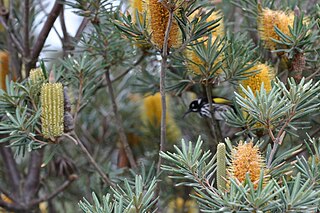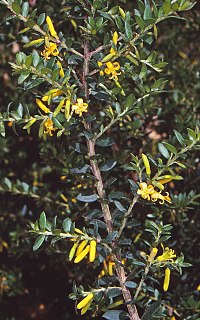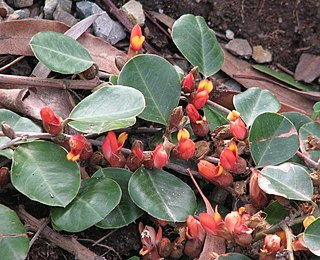
Persoonia is a genus of about one hundred species of shrubs and small trees in the subfamily Persoonioideae in the large and diverse plant family Proteaceae. In the eastern states of Australia, they are commonly known as geebungs, while in Western Australia and South Australia they go by the common name snottygobbles. While their flowers are small and not prominent, persoonias are best known in the Australian bush for the striking bright green foliage of many species.
Banksia oligantha, commonly known as Wagin banksia, is an endangered species in the plant family Proteaceae endemic to south west Western Australia. It belongs to Banksia subg. Isostylis, a subgenus of three closely related Banksia species with dome-shaped heads as inflorescences, rather than characteristic Banksia flower spikes. A shrub or small tree up to 4 m (13 ft) high, it has prickly foliage and pink and cream flowerheads which appear in late Spring.

Banksia verticillata, commonly known as granite banksia or Albany banksia, is a species of shrub or (rarely) tree of the genus Banksia in the family Proteaceae. It is native to the southwest of Western Australia and can reach up to 3 m (10 ft) in height. It can grow taller to 5 m (16 ft) in sheltered areas, and much smaller in more exposed areas. This species has elliptic green leaves and large, bright golden yellow inflorescences or flower spikes, appearing in summer and autumn. The New Holland honeyeater is the most prominent pollinator, although several other species of honeyeater, as well as bees, visit the flower spikes.

Persoonia longifolia, the upright snottygobble, also known as the long-leaf persoonia or just snottygobble, is a species of tall shrub or small tree in the plant genus Persoonia, reaching 1 to 5 metres (3–17 ft) in height. It is found in the Jarrah forests of southwest Western Australia. This species is characterised by its long narrow dark green leaves, dark yellow to orange flowers and distinctive flaky dark red bark.
Banksia montana, commonly known as the Stirling Range dryandra, is a shrub of the family Proteaceae endemic to Western Australia, where it grows only in the Stirling Range. It was known as Dryandra montana until 2007.

Persoonia levis, commonly known as the broad-leaved geebung, is a shrub native to New South Wales and Victoria in eastern Australia. It reaches 5 m (16 ft) in height and has dark grey papery bark and bright green asymmetrical sickle-shaped leaves up to 14 cm (5.5 in) long and 8 cm (3.2 in) wide. The small yellow flowers appear in summer and autumn, followed by small green fleshy fruit, which are classified as drupes. Within the genus Persoonia, it is a member of the Lanceolata group of 58 closely related species. P. levis interbreeds with several other species where they grow together.

Persoonia lanceolata, commonly known as lance-leaf geebung, is a shrub native to New South Wales in eastern Australia. It reaches 3 m (9.8 ft) in height and has smooth grey bark and bright green foliage. Its small yellow flowers grow on racemes and appear in the austral summer and autumn, followed by green fleshy fruits which ripen the following spring. Within the genus Persoonia, P. lanceolata belongs to the lanceolata group of 58 closely related species. It interbreeds with several other species found in its range.

Persoonia laurina, commonly known as the laurel-leaved or laurel geebung, is a shrub of the family Proteaceae native to central New South Wales in eastern Australia. Found in sclerophyll forest, it grows to a height of 2 metres. The yellow flowers appear in late spring.

Persoonia myrtilloides, commonly known as myrtle geebung, is a shrub species that is endemic to New South Wales in Australia. It grows to between 0.5 and 2.5 metres in height and has leaves that are between 12 and 50 millimetres long and 4 to 30 millimetres wide. Yellow flowers appear between December and April in the species native range.

Persoonia hirsuta, commonly known as the hairy persoonia or hairy geebung, is a shrub native to New South Wales in eastern Australia.

Persoonia marginata, commonly known as the Clandulla geebung, is a plant in the family Proteaceae and is endemic to New South Wales. It is low, spreading shrub with elliptic to egg-shaped leaves and small groups of cylindrical yellow flowers.

Persoonia gunnii, commonly known as the mountain geebung, is a slow-growing shrub endemic to wet forests and subalpine shrubberies in Tasmania. It forms a bush ranging from 0.6 to 3 m in height with short, up-curved leaves and scented cream-yellow flowers in summer giving way to small dark purple fruit. It is a common shrub in subalpine areas of the state and is occasionally confused with P. muelleri.

Persoonia muelleri, commonly known as Mueller’s geebung, is a shrub endemic to Tasmania. It forms a shrub in open areas of wet forests in the west and northeast of the state. It is occasionally confused with P. gunnii though it has larger flowers and longer, straighter leaves.
Persoonia moscalii, commonly known as the creeping geebung, is a shrub native to southwestern Tasmania.

Persoonia falcata, commonly known as the wild pear, is a shrub native to northern Australia.

Persoonia asperula, commonly known as mountain geebung, is a plant in the family Proteaceae and is endemic to south-eastern Australia. It is an erect or prostrate shrub with smooth bark, mostly elliptic to oblong leaves and yellow flowers borne singly or in groups of up to nine. It mostly occurs in the Southern Highlands of New South Wales. A small population in Victoria may be a different species.

Darwinia collina, commonly known as the yellow mountain bell, is a plant in the myrtle family Myrtaceae. It grows as an erect shrub 0.3–1.2 metres (1–4 ft) high with crowded elliptical leaves and bright yellow flower-like inflorescences. It is endemic to a few small areas in the Stirling Range National Park, Western Australia and as a result is classified as an endangered species.

Persoonia terminalis, also known as the Torrington geebung, is a rare shrub belonging to the family Proteaceae, and native to northern New South Wales and southern Queensland in eastern Australia. Reported as a subspecies of Persoonia nutans in 1981, it was described as a species by Lawrie Johnson and his colleague Peter Weston in 1991.

Persoonia sulcata is a plant in the family Proteaceae and is endemic to the south-west of Western Australia. It is a small, erect or low spreading shrub with narrow, linear leaves and cylindrical yellow flowers arranged singly or in groups of up to three in leaf axils. It grows in woodland or on rocky slopes and is found in several disjunct populations.

Persoonia saccata, commonly known as snottygobble, and cadgeegurrup in indigenous language, is a plant in the family Proteaceae and is endemic to the south-west of Western Australia. It is usually an erect shrub and has linear leaves and groups of up to fifty or more irregularly shaped, yellow flowers which are hairy on the outside. It usually grows in woodland dominated by jarrah, marri or large Banksia species.






















